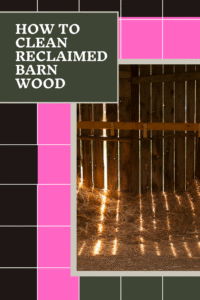Fingerprint Balloon Card
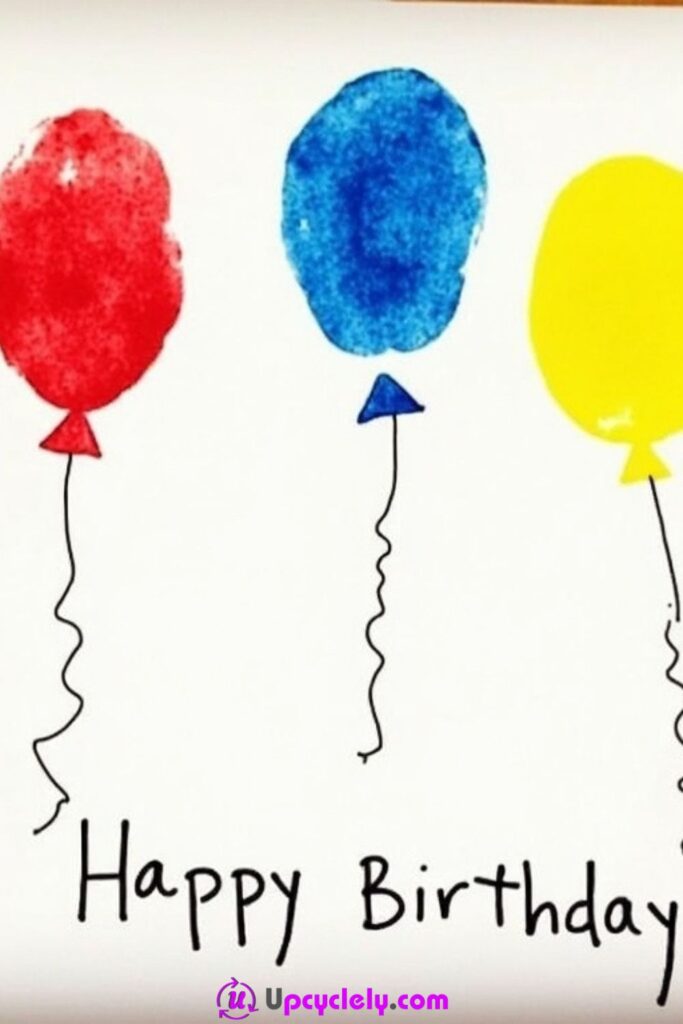
Materials Needed:
- White cardstock or thick paper
- Red, blue, and yellow ink pads
- Black pen or marker
- Wet wipes (to clean fingers)
- Ruler (optional)
Steps:
- Start by folding the white cardstock in half to form the base of your card.
- Choose your first ink color (I usually start with red), and press your index finger onto the ink pad. Then, firmly press your finger onto the top left section of the card to create the first balloon. Clean your finger with a wet wipe.
- Repeat the process with the blue and yellow ink pads, stamping one balloon in the middle and one on the right. Make sure they’re spaced evenly for a balanced look.
- Using a black pen, draw small triangles at the base of each fingerprint to create the balloon knots.
- Extend a wavy line downward from each triangle to replicate the balloon strings. Keep them playful and squiggly!
- Finish by handwriting “Happy Birthday” in a whimsical font below the balloons. That little touch adds charm and personality.
Pro Tip:
For a more professional look, lightly sketch the balloon placements with a pencil before stamping. This helps keep everything centered and neat!
Button-Bouquet Card
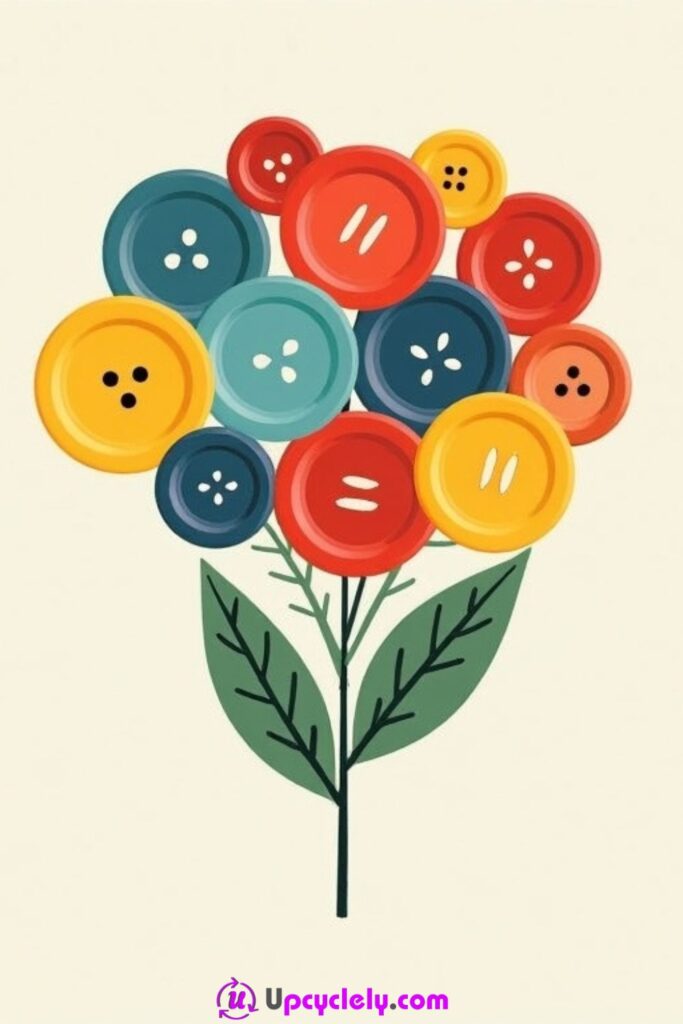
Materials Needed:
- Assorted colorful buttons (various sizes)
- Green marker or thin paintbrush
- White or cream-colored cardstock
- Craft glue
- Green construction paper for leaves (optional)
- Scissors
Steps:
Allow the glue to dry completely before closing or packaging the card.
Begin by folding your cardstock in half to make the card base. I find cream-colored cardstock works best for creating a warm look.
Lay out your buttons in a circular arrangement on the front of the card to mimic a floral bouquet. Place the larger buttons in the center and surround them with smaller ones in varying colors like red, teal, yellow, and blue. Once you’re happy with the layout, glue each button in place.
Use a green marker or thin paintbrush to draw stems extending from each button downward, meeting in a cluster at the base of the bouquet.
Cut out two small leaf shapes from green construction paper and glue them at the bottom of the bouquet for a more realistic touch. If you’re short on paper, you can also draw the leaves directly onto the card.
Pro Tip:
Use textured or patterned buttons for added depth and creativity. Mixing matte and glossy buttons makes the bouquet even more eye-catching.
Candle Stick Card
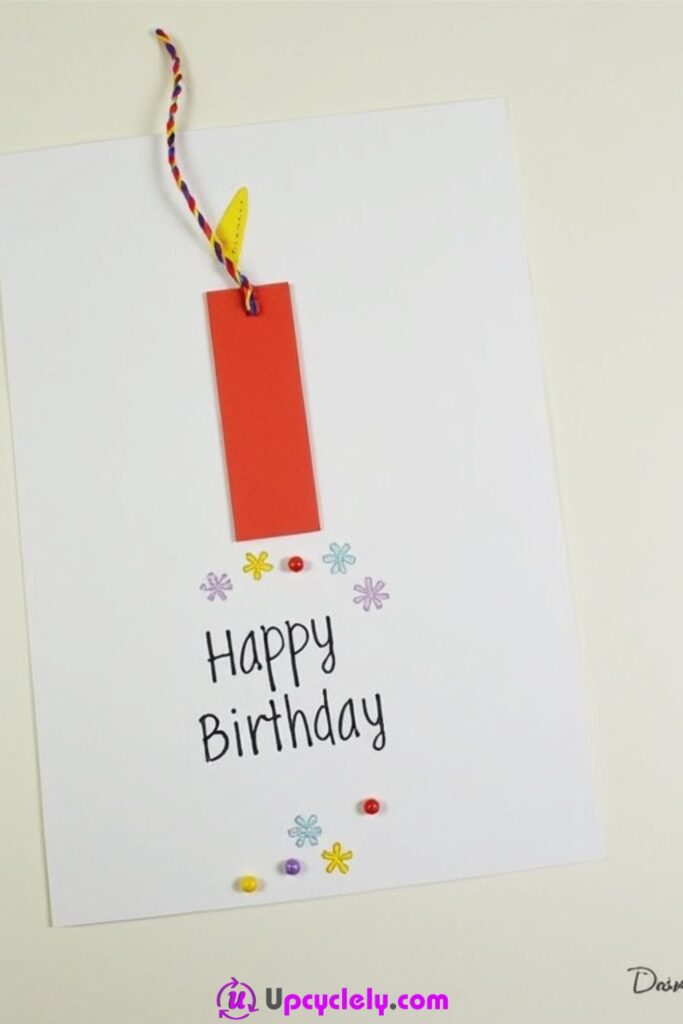
Materials Needed:
- White cardstock
- Small rectangular tags (I use red and yellow)
- Multicolored embroidery thread or thin string
- Fine-tip markers (assorted colors)
- Hole punch
- Craft glue or tape
Steps:
- Fold your cardstock in half to form the card base. Set it aside for now.
- Take a small red rectangular tag and punch two holes at the top. Cut a piece of embroidery thread and loop it through the holes, creating a little string bow above the tag. Repeat this step with a smaller yellow tag, layering it over the red one like a flame.
- Glue the tags at the top center of the card. Below them, write “Happy Birthday” by hand in a playful font.
- Around the text, use fine-tip markers to draw small embellishments like flowers or confetti. I suggest alternating colors for a festive vibe!
- For added flair, you can attach additional small tags or even tie a ribbon to the card.
Pro Tip:
If you don’t have tags, you can create your own using stiff paper or cardstock. Just cut out rectangles, punch holes, and you’re good to go!
Confetti Card
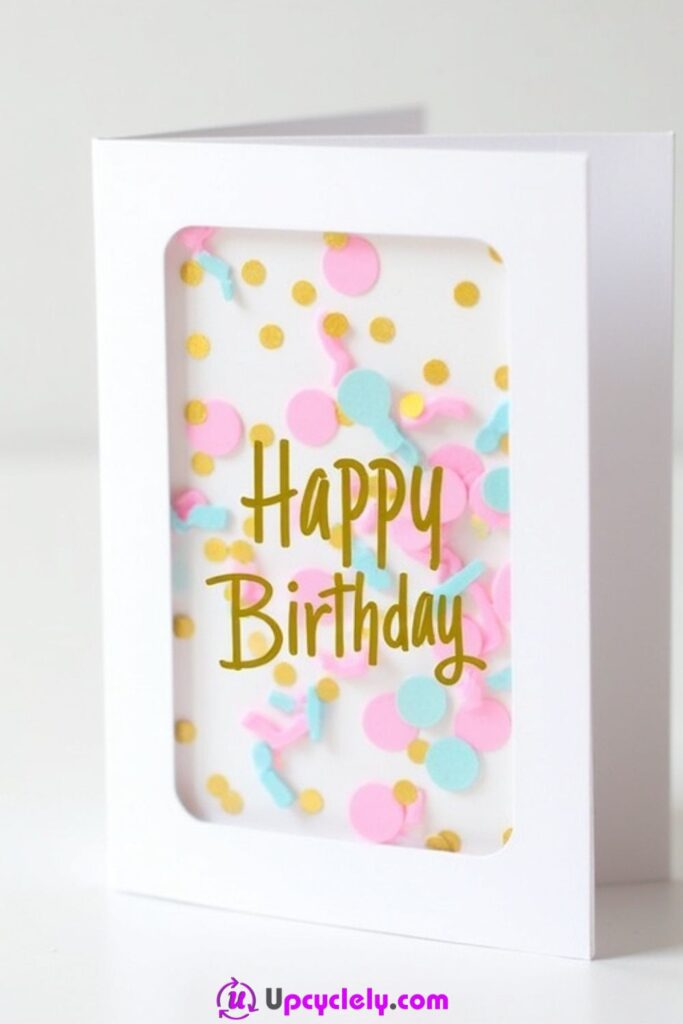
Materials Needed:
- White cardstock with a precut window (or cut one yourself with a craft knife)
- Colored paper (pink, yellow, blue)
- Hole punch for creating confetti
- Glue stick or double-sided tape
- Gold marker for text
Steps:
- Prepare your cardstock by ensuring the window is cleanly cut. If you’re cutting it yourself, measure and mark a rectangle with a pencil before carefully slicing with a craft knife.
- Use a hole punch to create confetti from pink, yellow, and blue paper. Scatter the confetti on a flat surface to plan your layout.
- Apply double-sided tape or glue stick to the edges of the window area. Gently press the confetti into the adhesive, filling the space with a colorful, scattered design.
- Write “Happy Birthday” in bold letters with your gold marker, centering it over the window. The gold text adds a touch of elegance.
- Allow the glue to dry completely before handling. Now you’ve got a card that’s both minimalistic and fun!
Pro Tip:
Laminate a thin layer of clear plastic behind the confetti window for a more polished look and to secure the confetti in place.
Embossed Heart Cards
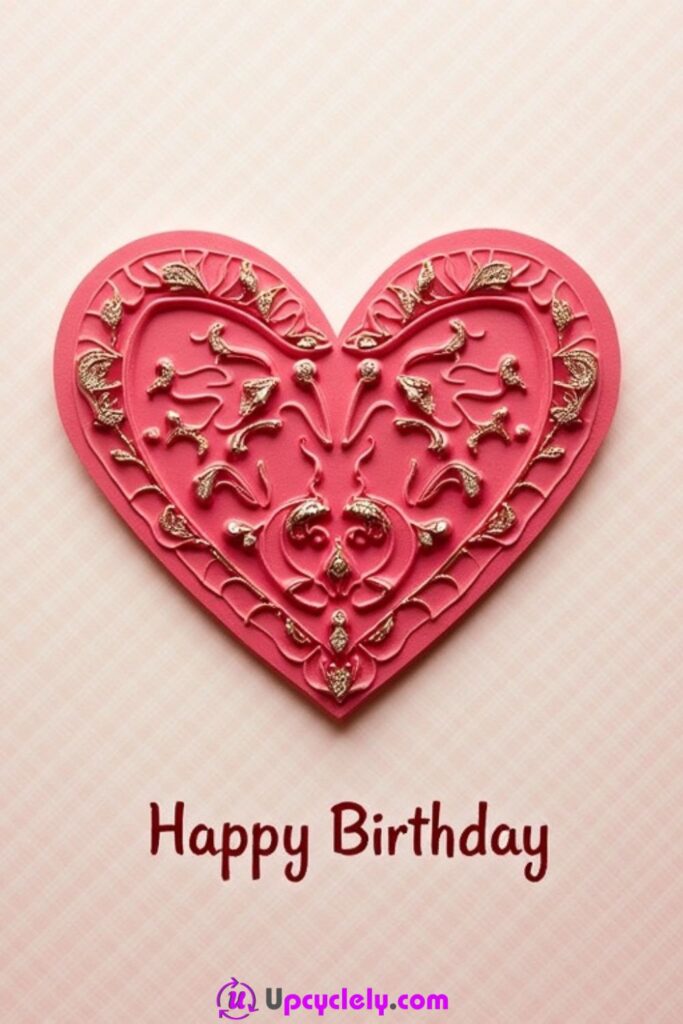
Materials Needed:
- Blank pink card stock
- Gold embossing powder
- Embossing pen
- Heat gun
- Ruler
- Decorative corner embellishments (optional)
- “Happy Birthday” stamp
- Ink pad (gold)
Step-by-Step Guide:
- Prepare the Card Base
I start by folding the pink card stock neatly in half to form the card. To add a more polished look, I use a ruler to ensure the edges align perfectly. Once the base is ready, I select an area on the card’s front where the embossed heart will go. - Create the Embossed Heart
Using an embossing pen, I draw a large heart shape in the center of the card. I love adding intricate floral and vine patterns across the heart for extra flair. Once the design is complete, I sprinkle gold embossing powder over it, ensuring it sticks to all the drawn areas. - Set the Design
Next, I shake off the excess powder and use a heat gun to melt and set the embossing powder. Watching the powder transform into a beautiful, glossy golden texture is always so satisfying! It gives the card an elegant, raised finish. - Finishing Touches
Below the heart, I stamp “Happy Birthday” in gold ink for a cohesive look. If I want to elevate the design further, I stick decorative corner embellishments in all four corners of the card. These small details make the card truly stunning.
Pro Tip:
For a neat and professional embossing effect, always work on a clean, flat surface and use an anti-static pouch before applying embossing powder to avoid smudges.
Interactive Scratch-Off Card
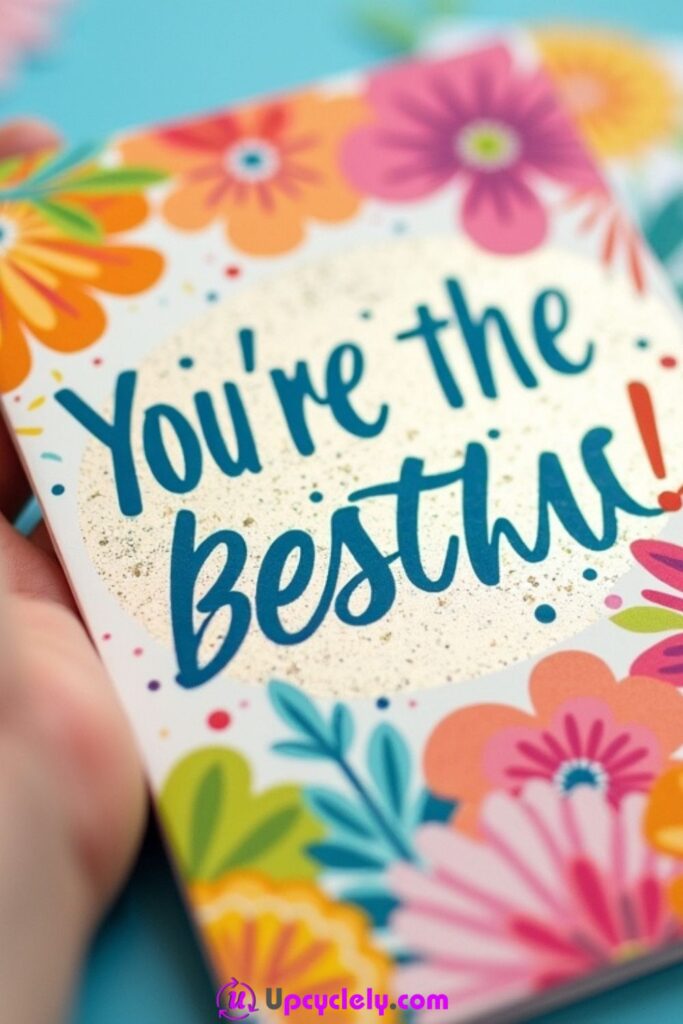
Materials Needed:
- Blank greeting card
- Acrylic paint (metallic silver or gold)
- Dish soap
- Clear packing tape
- Card stock (for DIY scratch-off stickers)
- Scissors
- Markers or pens
Step-by-Step Guide:
- Design the Base
I begin by writing or printing a hidden message inside my card, like “Happy Birthday!” or something playful like, “Scratch to reveal your birthday wish!” Next, I decorate the card’s surface with flowers or balloons using markers for an artistic touch. - Create Scratch-Off Stickers
I cut small shapes (like circles or stars) from card stock to cover the hidden message. Then, I completely cover each cutout with clear packing tape to make them waterproof. - Mix and Apply Paint
For the scratch-off surface, I mix one part dish soap with two parts acrylic paint, creating a smooth consistency. This mixture is key to making the scratchable area. I apply the paint evenly over the taped cutouts and wait for it to dry before adding a second coat. - Attach Stickers
Once the paint is dry, I secure the scratch-off stickers over the hidden message inside the card. When the recipient scratches off the area, they’ll unveil the surprise message underneath!
Pro Tip:
Use metallic paint for a professional finish that stands out, and make sure the tape is smooth to prevent bubbles under the paint.
Glitter and Glam Card
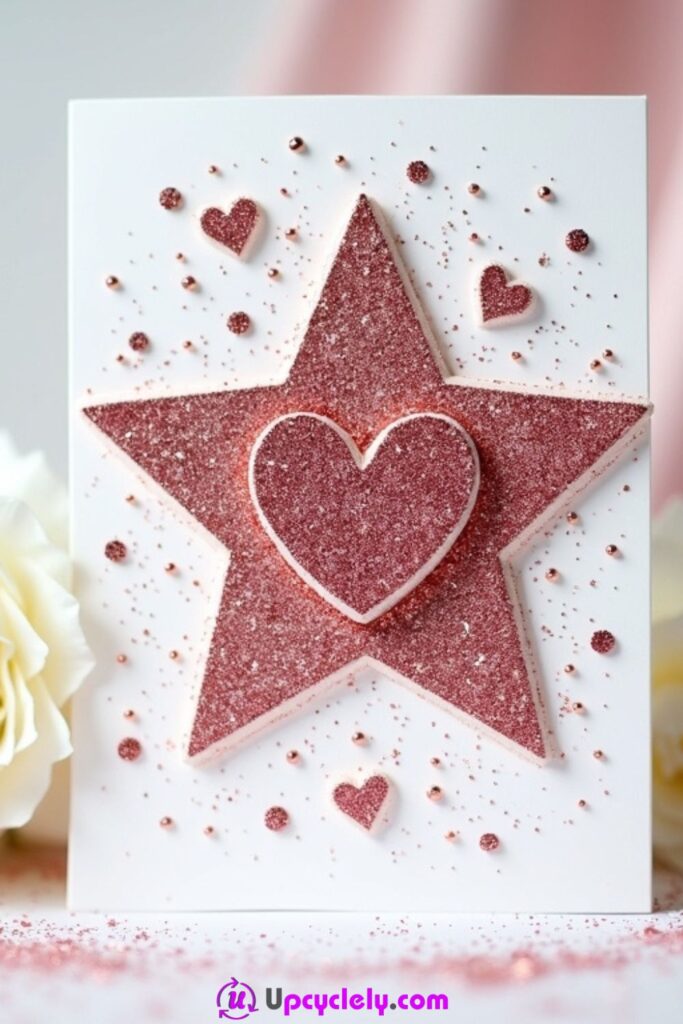
Materials Needed:
- White card stock
- Pink glitter paper
- Glitter glue
- Star-shaped stencil
- Adhesive gems
- Scissors
- Double-sided tape
Step-by-Step Guide:
- Prepare the Star
I start by cutting a large star shape from pink glitter paper using a stencil for precision. To make the star even more eye-catching, I glue a smaller heart-shaped cutout in the center of the star. - Design the Card Base
Using a piece of white card stock, I fold it in half to create the base. I evenly apply double-sided tape to secure the glittery star onto the center of the front panel. - Add Small Details
Around the large star, I use glitter glue to draw tiny dots and stars that complement the central design. Adding adhesive gems around the card’s edges gives the entire piece a glamorous and stylish touch. - Finishing Touches
To tie everything together, I scatter smaller pink hearts (cut out using glitter paper) around the star. This creates balance and makes the card pop with charm and sparkle.
Pro Tip:
Always work on newspaper or a crafting mat when using glitter to avoid making a mess and damaging your workspace.
Hand-Drawn Doodles Card
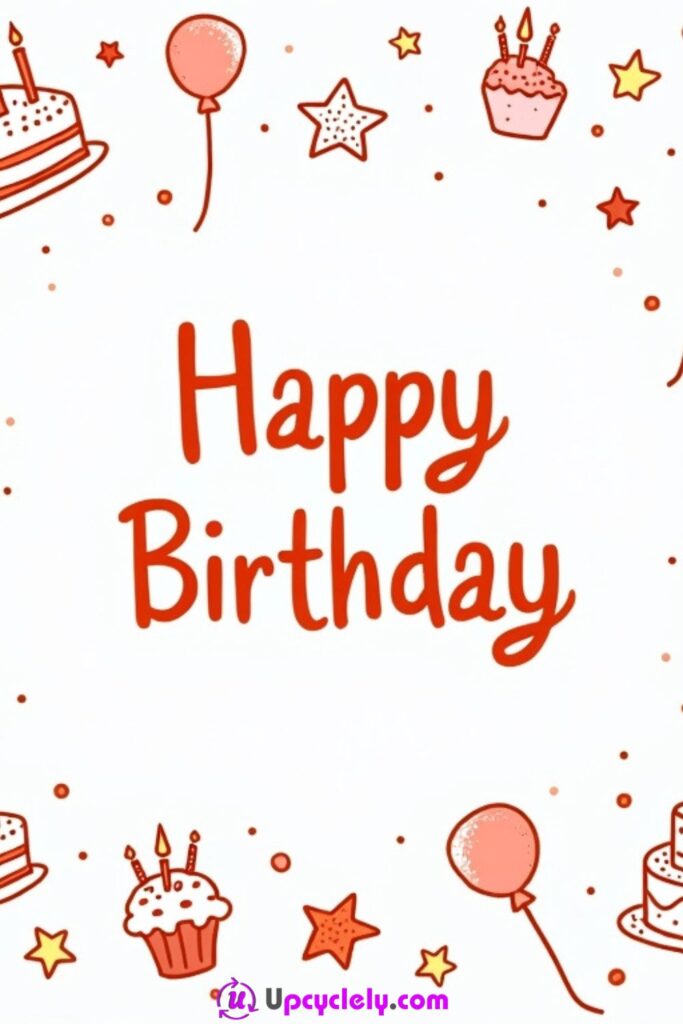
Materials Needed:
- Blank card stock (white)
- Fine-tip markers (red, orange, black)
- Pencil (for sketching outlines)
- Eraser
Step-by-Step Guide:
- Sketch the Layout
I lightly sketch the words “Happy Birthday” in the center of the card. Around the edges, I outline cakes, balloons, and stars, ensuring their placement creates a balanced border. - Bring the Design to Life
Using red and orange markers, I go over the “Happy Birthday” text to make it vibrant and bold. For the doodles, I use a combination of solid fills and outlines to create contrast in the cakes, balloons, and stars. This makes them look lively and fun. - Add Details
I love adding small details like stripes on the balloons, sprinkles on the cakes, and shading around the decorations to give the illustrations more depth and character. - Final Touches
After coloring everything, I clean up any pencil marks with an eraser to ensure the card looks crisp and polished. Finally, I use a black marker to add tiny dots around the border for a playful confetti effect.
Pro Tip:
Don’t worry about making the doodles perfect! Their hand-drawn charm is what makes the card feel unique and personal.
Stamped Pattern Card
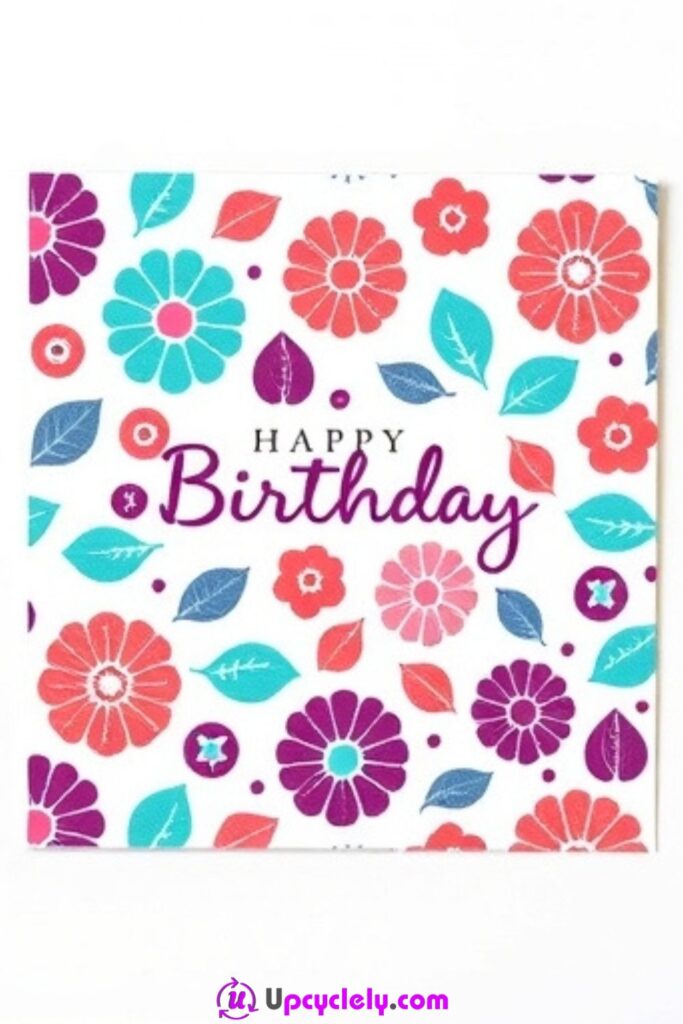
Materials Needed:
- Blank card stock (white or beige)
- Floral stamps (or any pattern stamp you like)
- Ink pads in vibrant colors (red, pink, purple, turquoise, and blue)
- Black ink pad for text
- “HAPPY Birthday” stamp
Step-by-Step Guide:
- Prepare Your Station I make sure my workspace is clean and laid out with everything I need before starting. I take a blank piece of card stock and fold it neatly in half to form the base of my card.
- Stamp the Floral Patterns I choose a combination of floral stamps and press them onto the colored ink pads. Then, I stamp the designs randomly over the front of the card to create a vibrant, playful background. I like to layer different colors for depth but keep a balanced layout to avoid overcrowding.
- Add the Birthday Greeting At the center of the card, I use the “HAPPY Birthday” stamp and black ink to make the greeting stand out. I press firmly and evenly for clean, sharp letters.
- Final Embellishments To finish up, I check for empty spaces and fill them with small leaves or flourishes using the smaller stamps. This gives the card a polished, complete look.
Pro Tip:
Rotate your stamps slightly with each press to make the patterns look more dynamic and natural, instead of too uniform.
Hand-Painted Floral Card
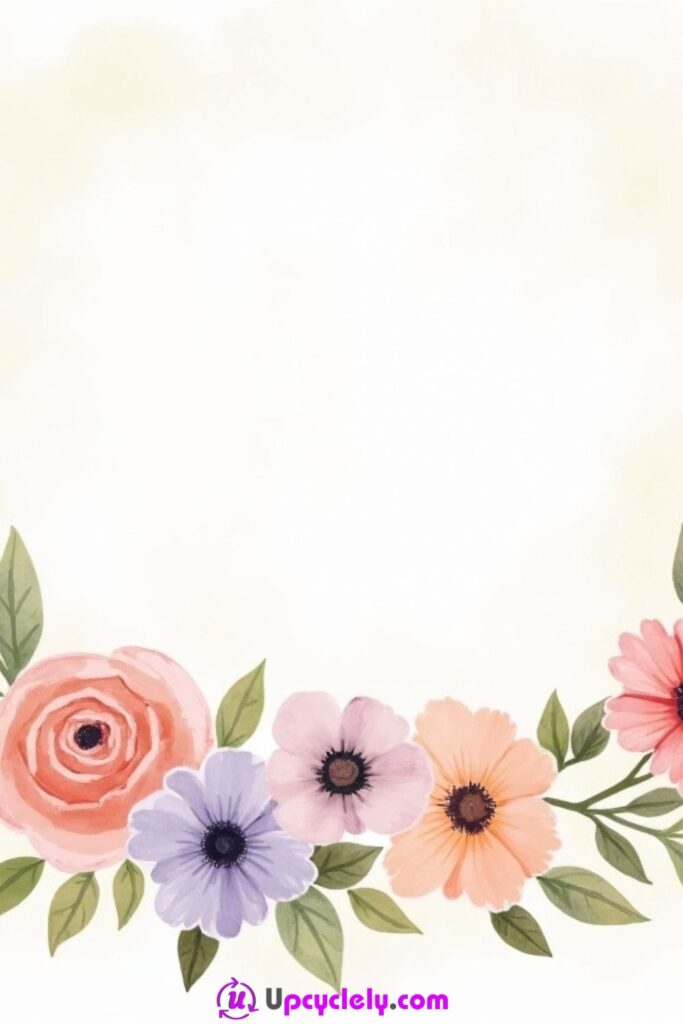
Materials Needed:
- Blank card stock (white or pastel-colored)
- Watercolor paints
- Paintbrushes (various sizes)
- Cup of water and a paper towel
- Pencil (for sketching, optional)
Step-by-Step Guide:
- Sketch the Layout I lightly sketch an arc-shaped floral arrangement at the bottom of the card. It helps me map where each flower and leaf will go when I start painting.
- Paint the Flowers Using watercolor paints, I begin with the largest flower, usually a pink rose. I layer soft, rounded petals to create a blooming look. Next, I add smaller purple and orange flowers, painting either rounded or daisy-like patterns.
- Add the Leaves I paint green leaves extending outward around the flowers, connecting the arrangement. I keep the brushstrokes light and soft, keeping the watercolor aesthetic intact.
- Blend and Refine Once the flowers and leaves are dry, I use the same watercolor shades to deepen the colors and add shadows for dimension. For any stray pencil marks, I erase them gently.
Pro Tip:
Test your watercolor tones on scrap paper first! This helps you match the colors to avoid clashing hues.
Kraft Paper Birthday Card
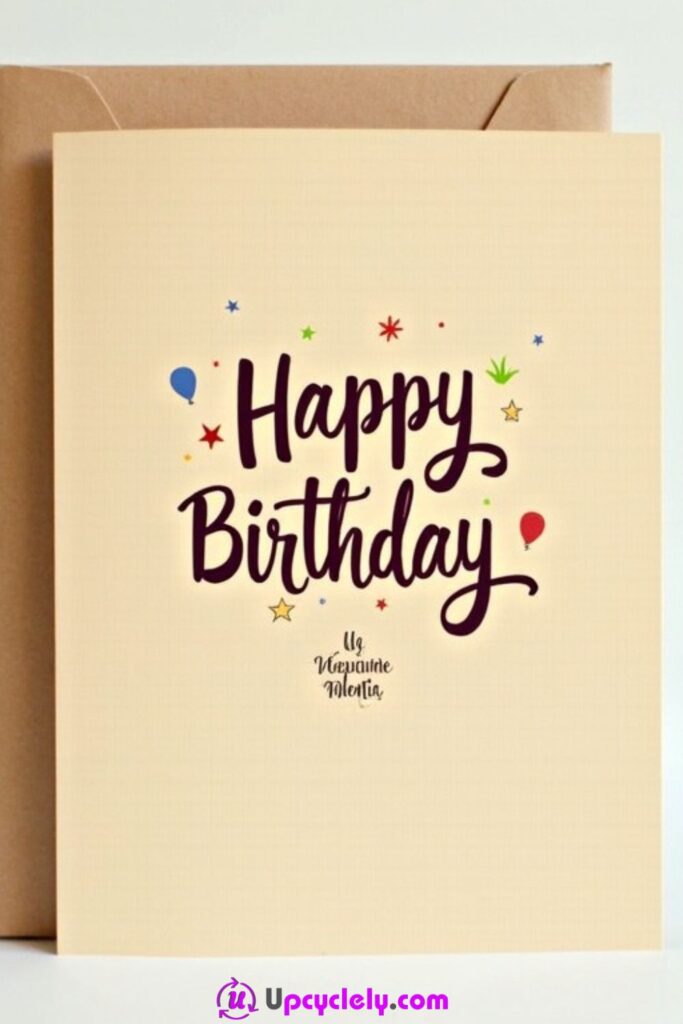
Materials Needed:
- Kraft paper card stock
- Dark purple script marker
- Contrasting colored markers (blue, green, red, and yellow)
- Decorative envelope
- Ruler (optional)
Step-by-Step Guide:
- Prepare the Base I fold a kraft paper card stock neatly in half. If the edges don’t align perfectly, I trim them with scissors to create a clean edge.
- Write the Birthday Greeting With a dark purple marker, I handwrite “Happy Birthday” in the center of the card. I use large, swirling script to give it a bold and elegant touch. For added precision, I optionally use a ruler to ensure my writing is centered.
- Decorate Around the Text Around the greeting, I draw colorful celebratory designs such as stars, balloons, and confetti using blue, green, red, and yellow markers. I start with the bigger designs and fill in with smaller dots and details.
- Pair it with a Matching Envelope To make the card even more special, I place it in a decorative envelope. Sometimes, I draw matching designs on the envelope’s flap to tie it all together.
Pro Tip:
Using metallic markers for some accents, like stars, will make the card more festive and give it a touch of shine!
Mini Pocket Card
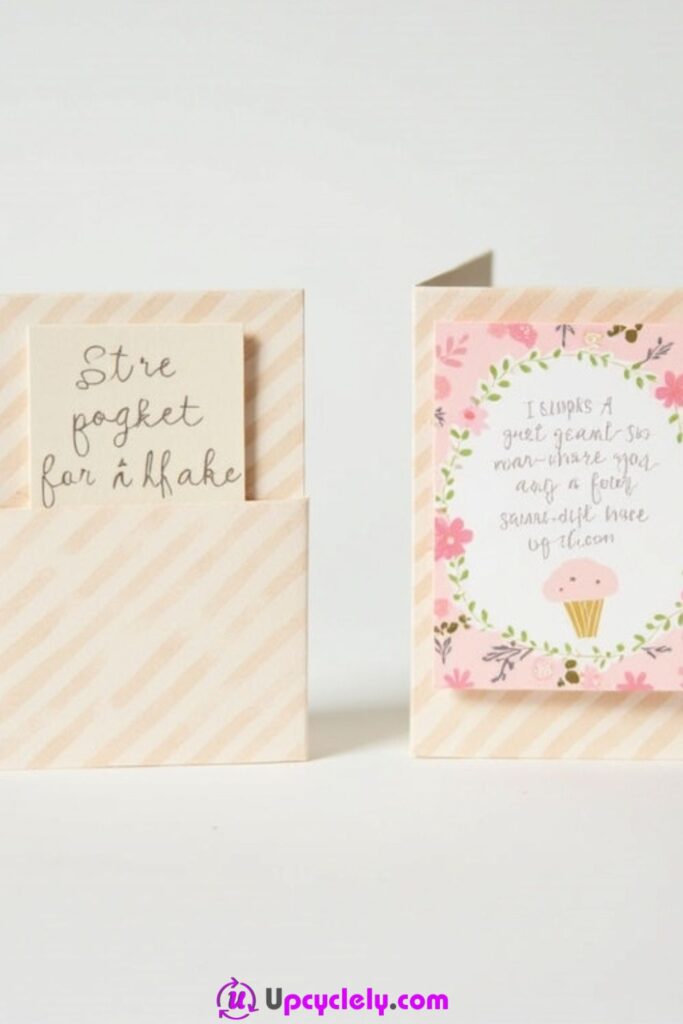
Materials Needed:
- Double-sided patterned paper
- Scissors
- Adhesive (glue stick or double-sided tape)
- Fine-tip markers
- Index card or small folded paper
Step-by-Step Guide:
- Create the Pocket Base I cut a rectangle out of double-sided patterned paper, fold it in half and glue or tape only the edges to create a pocket. This will serve as the base of the mini card.
- Add Decorations to the Pocket Using fine-tip markers, I draw playful patterns like stripes or polka dots on the pocket. If the patterned paper is already decorative enough, I stick to highlighting small edges or corners with extra designs.
- Write the Insert I take an index card or folded small piece of paper and write my birthday greeting on it. A simple “Happy Birthday!” or a cute joke works great. Then, I decorate the card with mini illustrations like balloons or a cupcake.
- Complete the Card I carefully slide the greeting insert into the pocket and make sure it peeks out a little for a playful effect. If I’m feeling extra creative, I add a small ribbon or tab to make pulling the card out easier.
Pro Tip: Use contrasting patterns for the pocket and the insert to make each part stand out distinctly.
Paper Strip Banners Card
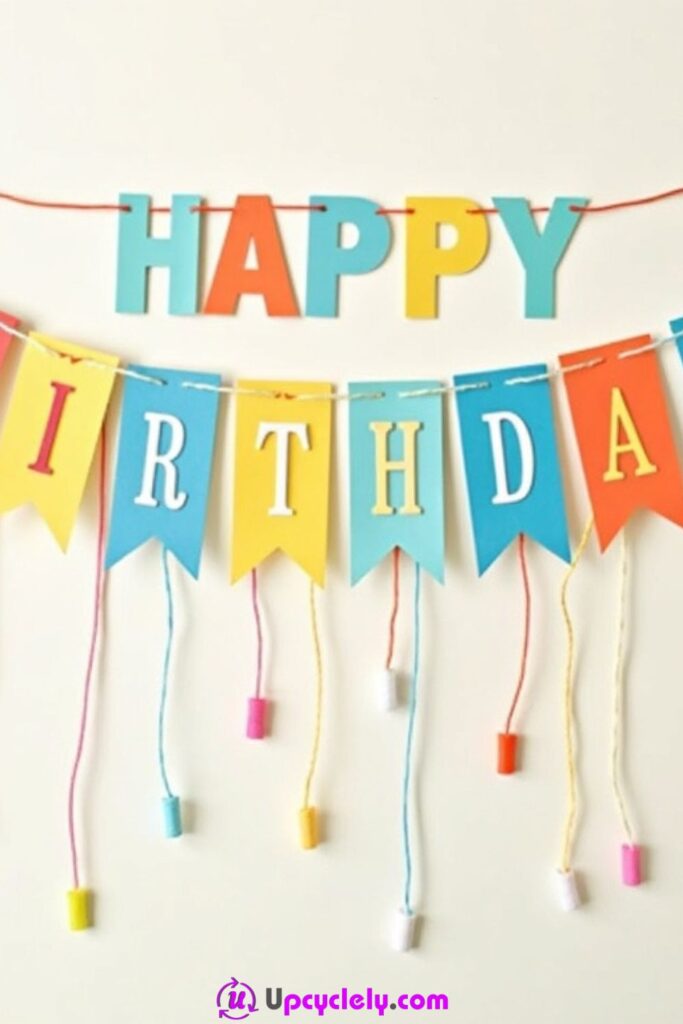
Materials Needed:
- Blank card stock (any color)
- Strips of colored paper (red, blue, yellow, orange)
- Glue stick
- Markers
- Hole punch and thin ribbon (optional)
Step-by-Step Guide:
- Cut and Prepare the Strips I cut even strips of colored paper to form the banners. I also trim the strips into triangle shapes at the bottom to create pennant-style flags.
- Attach Banner Pieces I position the strips on the front panel of the card in two rows, spelling out “HAPPY” on the top row and “BIRTHDAY” on the bottom. I glue each strip carefully, leaving a small gap between each banner.
- Write the Letters Using bold markers, I write one letter on each banner piece. I choose contrasting colors for the ink so the text pops against the paper strips.
- Add the Final Touch To enhance the festive vibe, I punch small holes at the edges of the card and thread a thin ribbon through, mimicking the look of a hanging banner. I tie it off with small bows at the sides for extra charm.
Pro Tip:
Layer glitter glue or sticker accents around the banners to give the card a fun, party-ready look.
Wash Tape Design Card
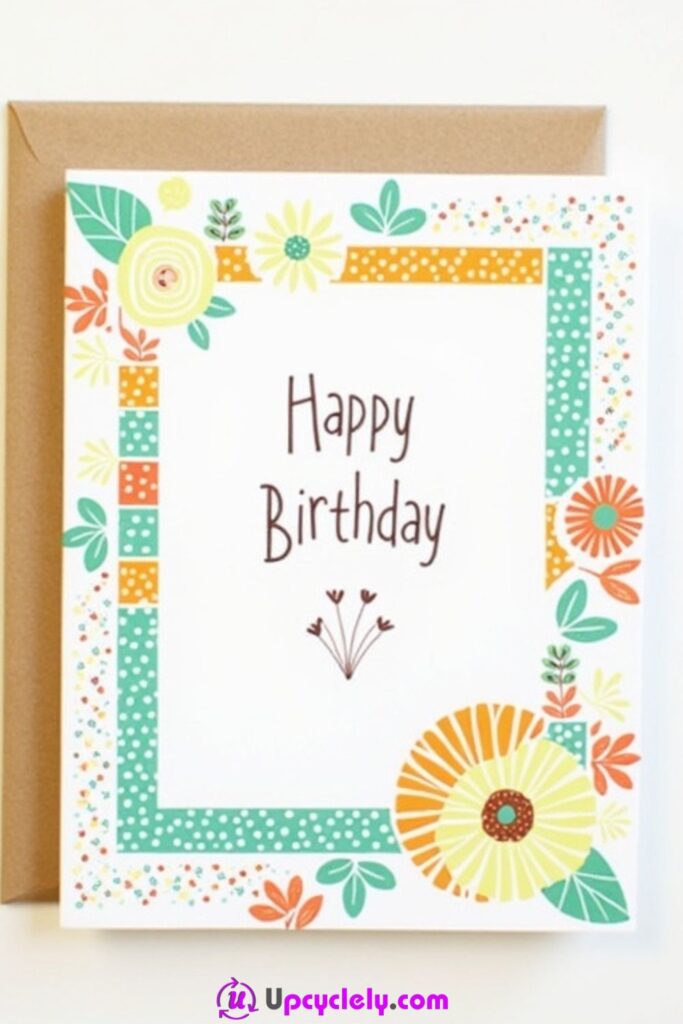
Materials Needed:
- Blank card stock (white or off-white)
- Washi tape in various colors/patterns (e.g., floral, polka-dot, striped)
- Scissors or a craft knife
- Ruler (optional to align tape edges neatly)
- Fine-tip black marker or pen
- “Happy Birthday” stamp or stickers (optional)
Step-by-Step Guide:
1. Prepare Your Card Base
First, I start by folding my blank card stock neatly in half to create the base for my greeting card. I make sure the edges align perfectly by running a ruler along the fold to get a crisp crease. A clean, smooth fold creates a professional look and makes it easier to design the front panel.
If you’d like to create a smaller card, feel free to trim the card stock first to your desired size, ensuring it fits your envelope. Personally, I think a smaller card (around 4×6 inches) has a cozy and charming appeal.
2. Arrange the Washi Tape Border
This step is where the fun begins! I pick out my favorite washi tapes with vibrant and playful patterns. Starting from the top left corner of the card, I carefully apply a strip of washi tape along the edge to form the top border. I keep the tape straight and smooth by pressing it down firmly and aligning it with the card’s edge. Then, I trim off any excess tape using scissors for a neat finish.
Next, I continue this process for all four edges of the card, using different washi tape designs that complement one another. The mix of patterns gives the card a dynamic and eye-catching look. Using floral or geometric designs can help elevate the overall appearance.
3. Add the “Happy Birthday” Text
Now it’s time to add the star of the card—the birthday greeting! I center the text on the front panel using a fine-tip black marker for a handwritten touch. If freehand work isn’t your style, I suggest using a “Happy Birthday” stamp for perfectly neat letters or applying stickers for a three-dimensional look.
To frame the greeting, I love sketching a simple rectangular border using dashed or dotted lines. This little detail adds extra flair and ties the washi tape décor to the central text design.
4. Decorate with Finish Detailing
With the main elements in place, I add finishing touches to pull it all together. For this design, I like drawing small decorative hearts, stars, or floral doodles near the text using a pen. If I’m feeling extra creative, this is where I’ll add a pop of color with additional washi tape inside the rectangular border or as an accent around the corner of the card.
Finally, I take a step back and check if the card feels balanced. If it seems a bit empty or uneven, I’ll add small washi tape strips or fine marker dots within the open spaces to complete the look.
Pro Tip:
To avoid ripping thin washi tape while trimming, use a craft knife and cutting mat for ultra-clean edges. This technique ensures your tape maintains its crisp lines and professional appearance, especially near corners.


